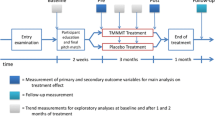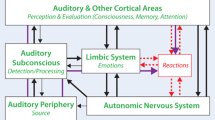Access this chapter
Tax calculation will be finalised at checkout
Purchases are for personal use only
Similar content being viewed by others
Abbreviations
- A1:
-
Primary auditory cortex
- A2:
-
Secondary auditory cortex
- ADT:
-
Auditory discrimination training
- AOIL:
-
Auditory object identification and localization
- ASSR:
-
Auditory steady-state response
- EAE:
-
Enriched acoustic environment
- LDL:
-
Loudness discomfort level
- LM:
-
Loudness matching
- MML:
-
Minimum masking level
- QE:
-
Quiet environment
- RI:
-
Residual inhibition
- THI:
-
Tinnitus handicap inventory
- THQ:
-
Tinnitus handicap questionnaire
- TRQ:
-
Tinnitus reaction questionnaire
- TRT:
-
Tinnitus retraining therapy
- TSI:
-
Tinnitus severity index
- VAS:
-
Visual analog scales
References
Jastreboff PJ (1995) Tinnitus as a phantom perception: Theories and clinical applications. In: Vernon J, Moeller AR, Editors. Mechanisms of Tinnitus. Boston, MA: Allyn and Bacon, pp. 73–94.
Henry JA, MA Schechter, TL Zaugg et al (2006) Outcomes of clinical trial: Tinnitus masking versus tinnitus retraining therapy. J. Am. Acad. Audiol. 17:104–132.
Robertson D, DRF Irvine (1989) Plasticity of frequency organization in auditory cortex of guinea pigs with partial unilateral deafness. J. Comp. Neurol. 282:456–461.
Rajan R, DRF Irvine (1998) Neuronal responses across cortical field A1 in plasticity induced by peripheral auditory organ damage. Audiol. Neurootol. 3:123–144.
Noreña AJ, M Tomita, JJ Eggermont (2003) Neural changes in cat auditory cortex after a transient pure-tone trauma. J. Neurophysiol. 90:2387–2401.
Rauschecker JP (1999) Auditory cortical plasticity: a comparison with other sensory systems. Trends Neurosci. 22:74–80.
Eggermont JJ, LE Roberts (2004) The neuroscience of tinnitus. Trends Neurosci. 27:676–682.
Fritz J, M Elhilali, S Shamma (2005) Active listening: task-dependent plasticity of spectrotemporal receptive fields in primary auditory cortex. Hear. Res. 206:159–176.
Weinberger NM (2007) Auditory associative memory and representational plasticity in the primary auditory cortex. Hear. Res. 229:54–68.
Finlayson PG, JA Kaltenbach (2009) Alterations in the spontaneous discharge patterns of single units in the dorsal cochlear nucleus following intense sound exposure. Hear. Res. doi:10.1016.
Cacace AT (2003) Expanding the biological basis of tinnitus: crossmodal origins and the role of neuroplasticity. Hear. Res. 175:112–132.
Shore SE, S Koehler, M Oldakowski, LF Hughes, S Syed (2008) Dorsal cochlear nucleus responses to somatosensory stimulation are enhanced after noise-induced hearing loss. Eur. J. Neurosci. 27:155–168.
Lanting CP, E de Kleine, P van Dijk (2009) Neural activity underlying tinnitus generation: Results from PET and fMRI. Hear. Res. 255:1–13.
Roberts LE, G Moffat, M Baumann et al (2008) Residual inhibition functions overlap tinnitus spectra and the region of auditory threshold shift. J. Assoc. Res. Otolaryngol. 9: 417–435.
Ross B, R Draganova, TW Picton, C Pantev (2003) Frequency specificity of 40-Hz auditory steady-state responses. Hear. Res. 186:57–68.
Pantev C, H Okamoto, B Ross, W Stoll, E Ciurlia-Guy, R Kakigi, T Kubo (2004) Lateral inhibition and habituation of the human auditory cortex. Eur. J. Neurosci. 19: 2337–2344.
Kadia SC, X Wang (2003) Spectral integration in A1 of awake primates: neurons with single and multipeaked tuning characteristics. J Neurophysiol. 89:1603–1622.
Plewnia C, M Reimold, A Najib, B Brehm, G Reischl, SK Plontke, C Gerloff (2007) Dose-dependent attenuation of auditory phantom perception (tinnitus) by PET-guided repetitive transcranial magnetic stimulation. Hum. Brain Mapp. 28:238–246.
Noreña AJ, S Chery-Croze (2007) Enriched acoustic environment rescales auditory sensitivity. NeuroReport 18:1251–1255
Noreña A, C Micheyl, S Chéry-Croze, L Collet (2002) Psychoacoustic characterization of the tinnitus spectrum: implications for the underlying mechanisms of tinnitus. Audiol. Neurootol. 7:358–369.
Kuk FK, RS Tyler, D Russell, H Jordan (1990) The psychometric properties of a tinnitus handicap questionnaire. Ear Hear. 11:434–445.
Meikle MB, SE Griest, BJ Stewart, LS Press (1995) Measuring the negative impact of tinnitus: A brief severity index. Abstr. Assoc. Res. Otolaryngol. p.167.
Newman CW, GP Jacobson, JB Spitzer (1996) Development of the tinnitus handicap inventory. Arch. Otolaryngol. Head Neck Surg. 122:143–148.
Wilson PH, J Henry, M Bowen, G Haralambous (1991) Tinnitus reaction questionnaire: psychometric properties of a measure of distress associated with tinnitus. J. Speech Hear. Res. 34:197–201.
Flor H, T Elbert, S Knecht, C Wienbruch, C Pantev, N Birbaumer et al (1995) Phantom limb pain as perceptual correlate of cortical reorganization. Nature 357:482–484.
Flor H, C Denke, M Schaefer, S Grusser (2001) Effect of sensory discrimination training on cortical reorganization and phantom limb pain. The Lancet 357:1763–1764.
Flor H, D Hoffmann, M Struve, E Diesch (2004) Auditory discrimination training for the treatment of tinnitus. Appl. Psychophysiol. Biofeedback 29(2):113–120.
Burns E (1984) A comparison of variability among measurements of subjective tinnitus and objective stimuli. Audiology 23:426–440.
Herriaz C, I Diges, P Cobo, G Plaza, J Aparicio (2006) Auditory discrimination therapy (ADT) for tinnitus management: preliminary results. Acta Oto-Laryngologica 126:8083.
Herriaz C, I Diges, P Cobo, J Aparicio (2009) Cortical reorganization and tinnitus: principles of auditory discrimination training for tinnitus management. Eur. Arch. Otorhinolaryngol. 266:9–16.
Roberts LE, DJ Bosnyak (2010) Neural synchrony and neural plasticity in tinnitus. In: Searchfield GD, Goodey R Editors. Proceedings of Tinnitus Discovery: Asia-Pacific Tinnitus Symposium. N. Z. Med. J. 123:39–50.
Bosnyak DJ, RA Eaton, LE Roberts (2004) Distributed auditory cortical representations are modified by training at pitch discrimination with 40-Hz amplitude modulated tones. Cereb. Cortex 14:1088–1099.
Kilgard MP, PK Pandya, J Vazquez, A Gehi, CE Schreiner, MM Merzenich (2001) Sensory input directs spatial and temporal plasticity in primary auditory cortex. J. Neurophysiol. 86:326–338.
Searchfield G, J Morrison-Low, K Wise (2007) Object identification and attention training for treating tinnitus. Prog. Brain Res. 166:369–75.
Baguley D, M Atlas (2007) Cochlear implants and tinnitus. Prog. Brain Res. 166:369–375.
Folmer R, J Carroll (2006) Long-term effectiveness of ear-level devices for tinnitus. Otolaryng. Head Neck Surg. 134:132–137.
Moffat G, K Adjout, S Gallego, H Thai-Van, L Collet, A Norena (2009) Effects of hearing aid fitting on the perceptual characteristics of tinnitus. Hear. Res. 254:82–91.
Noreña A, JJ Eggermont (2005) Enriched acoustic environment after noise trauma reduces hearing loss and prevents cortical map reorganization. J. Neurosci. 25(3):699–705.
Noreña A, JJ Eggermont (2006) Enriched acoustic environment after noise trauma abolishes neural signs of tinnitus. Neuroreport 17(6):559–563.
Pienkowski M, JJ Eggermont (2009) Long-term, partially-reversible reorganization of frequency tuning in mature cat primary auditory cortex can be induced by passive exposure to moderate-level sounds. Hear. Res. 257:24–40.
Gander PE, DJ Bosnyak, LE Roberts (2010) Acoustic experience but not attention modifies neural population phase expressed in human primary auditory cortex. Hear. Res. doi:10.1016 (on-line ahead of print).
Ross B, K Tremblay (2009) Stimulus experience modifies auditory neuromagnetic responses in young and older listeners. Hear. Res. 248:48–59.
Sheehan KA, GM McArthur, DV Bishop (2005) Is discrimination training necessary to cause changes in the P2 auditory event-related brain potential to speech sounds? Brain Res. Cogn. Brain Res. 25:547–553.
Stanton SG, RV Harrison (1996) Abnormal cochleotopic organization in the auditory cortex of cats reared in a frequency augmented environment. Aud. Neurosci. 2:97–107.
Davis PB, B Paki, PJ Hanley (2007) Neuromonics tinnitus treatment: third clinical trial. Ear Hear. 28(2):242–259.
Davis PB, RA Wilde, LG Steed, PJ Hanley (2008) Treatment of tinnitus with a customized acoustic neural stimulus: a controlled clinical study. Ear Nose Throat J. 87:330–339.
Hanley PJ, PB Davis, B Paki, SA Quinn, SR Bellekom (2008) Treatment of tinnitus with a customized, dynamic acoustic neural stimulus: Clinical outcomes in general private practice. Ann. Otol. Rhinol. Laryngol. 117:791–799.
Anari M, A Axelsson, A Eliasson, L Magnusson (1999) Hypersensitivity to sound – questionnaire data, audiometry and classification. Scand. Audiol. 28:219–230.
Formby C, LP Sherlock, SL Gold (2003) Adaptive plasticity of loudness induced by chronic attenuation and enhancement of the acoustic background. J. Acoust. Soc. Am. 114:55–58.
Munro KJ, J Blount (2009) Adaptive plasticity in brainstem of adult listeners following earplug-induced deprivation. J. Acoust. Soc. Am. 126:568–571.
Okamoto H, C Pantev, H Stracke, O Thiede (2009) Listening to tailor-made music reverses maladaptive auditory cortex reorganization and alleviates tinnitus. Proc. Natl. Acad. Sci. USA; doi:10.1073/pnas.0911268107.
Jepsen K, MP Sanders, GD Searchfield, K Kobayashi (2009) Perceptual training for tinnitus management. Tinnitus Discovery: Asia Pacific Tinnitus Symposium, Auckland, 11–12 September.
Guenther F, F Husain, M Cohen, B Shinn-Cunningham (1999) Effects of categorization and discrimination training on auditory perceptual space. JASA 106:2900–2912.
Guenther FH, A Nieto-Castanon, SS Ghosh, JA Tourville (2004) Representation of sound categories in auditory cortical maps. J. Speech Lang. Hear. Res. 47:46–57.
Acknowledgements
Preparation of this chapter was assisted by grants from the Canadian Institutes for Health Research, the Natural Sciences and Engineering Research Council of Canada, the American Tinnitus Association, and the Tinnitus Research Initiative.
Author information
Authors and Affiliations
Corresponding author
Editor information
Editors and Affiliations
Rights and permissions
Copyright information
© 2011 Springer Science+Business Media, LLC
About this chapter
Cite this chapter
Roberts, L.E., Bosnyak, D.J. (2011). Auditory Training in Tinnitus. In: Møller, A.R., Langguth, B., De Ridder, D., Kleinjung, T. (eds) Textbook of Tinnitus. Springer, New York, NY. https://doi.org/10.1007/978-1-60761-145-5_72
Download citation
DOI: https://doi.org/10.1007/978-1-60761-145-5_72
Publisher Name: Springer, New York, NY
Print ISBN: 978-1-60761-144-8
Online ISBN: 978-1-60761-145-5
eBook Packages: MedicineMedicine (R0)




